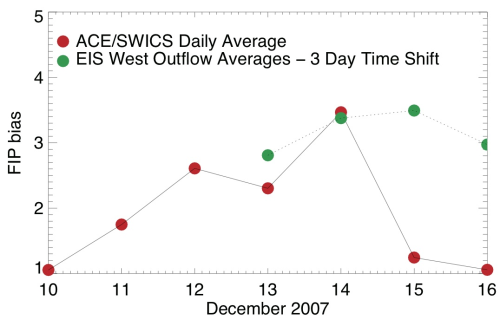Hinode has revealed the presence of high temperature (few MK) outflows at the edges of many active regions. These outflows show velocities of tens of km/s and appear to persist for at least several days. As an example, the
figure 1 below shows AR 10978 that crossed the solar disk in early to mid-December 2007.

Figure 1: SOHO/EIT images of AR 10978 with EIS field of view overlaid.
(Click figure to see full-size image)
The images are from SOHO/EIT, but the overlaid box is the field-of-view of diagnostic raster scans made by the EIS instrument on Hinode. Spectroheliograms obtained in the Fe XIII 202A line show close ups of the region below (
figure 2).

Figure 2: EIS Fe XIII 202A intensity maps.
(Click figure to see full-size image)
The outflows are present on both the solar East and West sides of the active region. Doppler velocity maps obtained in this line show the blue-shifted outflow emission first on the West side only, then on both sides, and then only on the East, as the active region rotates across the disk over 5 days (
figure 3).

Figure 3: EIS Fe XIII 202A Doppler velocity maps.
(Click figure to see full-size image)
The persistence of these outflows, and the fact that they appear to lie on open field lines, has generated excitement because they could be a source of plasma that makes a significant contribution to the slow speed solar wind. This nugget discusses one way that we are attempting to prove this connection.
The EIS instrument is able to measure the chemical composition in different solar features by measuring emission lines from ions with different first ionization potentials (FIP). Elements with a low FIP, such as Fe and Si, are generally enriched in the corona compared to the higher FIP elements, such as C, N, O, Ne, and S. We refer to the abundance ratio of the high to low FIP elements as the “FIP bias.” Measurements of the FIP bias can sometimes be used to determine the source (photosphere or corona) of the emitting plasma. Uri Feldman and co-workers assessed many of the spectral lines in the EIS wavelength bands to determine which ones could be useful for this purpose. Building on their work, we developed the methodology and show an application of the EIS capability here by measuring the FIP bias in the outflows of AR 10978. Since the composition of the slow speed wind is known to be generally close to coronal, the composition in the outflows should also be coronal if they really do contribute to the slow speed wind.
We measured the FIP bias in a sample of locations in the outflows over the 5 day period from Dec 10-15. The chosen locations are shown as small boxes on the Doppler velocity maps above. The values obtained are shown in the
figure 4 below. The FIP bias is found to be in the range 2.5-4.2 in all cases. The composition in the outflows is therefore enriched with low FIP elements by a factor of 3-4. This is consistent with the expected composition of the slow speed wind, and suggests that the plasma in the outflows really does contribute to the wind.

Figure 4: Measurements of FIP bias in 40 locations in the outflows between Dec. 10 and 15.
(Click figure to see full-size image)
An even better way to prove a connection is to measure the FIP bias in the outflow and then measure the FIP bias again in the solar wind after the plasma has had time to travel to the near Earth environment 3 days later. In fact this is also possible, because the Solar Wind Ion Composition Spectrometer (SWICS) on the ACE spacecraft can sample the solar wind composition in situ near Earth. The western outflow was favorably oriented toward Earth on Dec. 10th and 11th, so the SWICS measurements on Dec. 13th and 14th should correspond to the EIS measurements on these dates. We have made this comparison for AR 10978 and the results are shown below (
figure 5).

Figure 5: Comparison of EIS and SWICS FIP bias measurements.
(Click figure to see full-size image)
As can be seen, there is a good match. The EIS measurements made on Dec 10th and 11th are within 20% of the SWICS measurements made on Dec 13th and 14th. The measurements diverge after AR 10978 has passed disk center and the outflows are no longer directed at Earth.
The high speed solar wind that originates in polar coronal holes makes for an interesting point of comparison. The FIP bias measured in situ for the high speed wind is usually close to 1, indicating a photospheric composition. EIS measurements in coronal holes are consistent with this, providing an important check on this methodology.
In conclusion, the composition of the plasma in the outflows of AR 10978 is the same as that of the slow wind at Earth. These results provide compelling evidence that active region outflows can indeed contribute to the slow speed solar wind. It remains to be seen whether this contribution is dominant or whether AR 10978 is a rare case. We are pursuing larger, more systematic studies.
The results in this nugget and the technical details of the methodology were published in
Brooks & Warren (2011), ApJ, 727, L13


